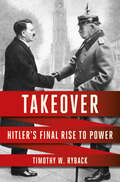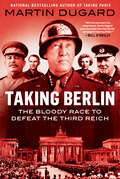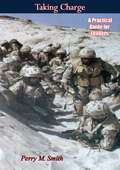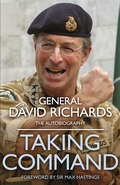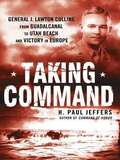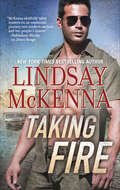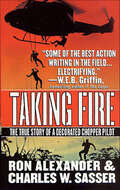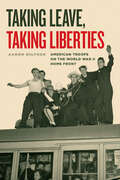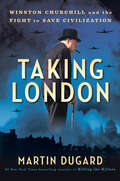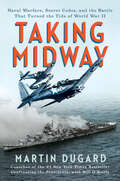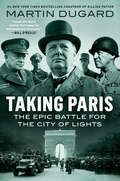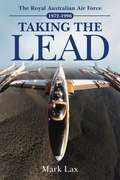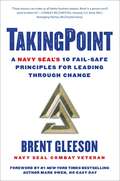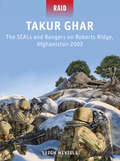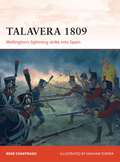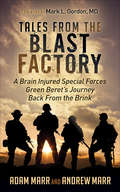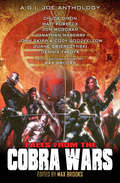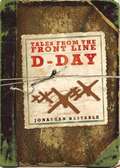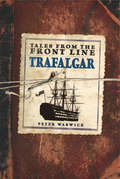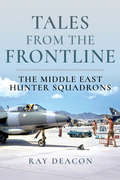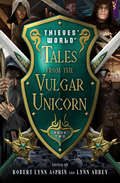- Table View
- List View
Takeover: Hitler's Final Rise to Power
by Timothy W. RybackFrom the internationally acclaimed author of Hitler&’s Private Library, a dramatic recounting of the six critical months before Adolf Hitler seized power, when the Nazi leader teetered between triumph and ruinIn the summer of 1932, the Weimar Republic was on the verge of collapse. One in three Germans was unemployed. Violence was rampant. Hitler&’s National Socialists surged at the polls. Paul von Hindenburg, an aging war hero and avowed monarchist, was a reluctant president bound by oath to uphold the constitution. The November elections offered Hitler the prospect of a Reichstag majority and the path to political power. But instead, the Nazis lost two million votes. As membership hemorrhaged and financial backers withdrew, the Nazi Party threatened to fracture. Hitler talked of suicide. The New York Times declared he was finished. Yet somehow, in a few brief weeks, he was chancellor of Germany. In facinating detail and with previously un-accessed archival materials, Timothy W. Ryback tells the remarkable story of Hitler&’s dismantling of democracy through democratic process. He provides fresh perspective and insights into Hitler&’s personal and professional lives in these months, in all their complexity and uncertainty—backroom deals, unlikely alliances, stunning betrayals, an ill-timed tax audit, and a fateful weekend that changed our world forever. Above all, Ryback details why a wearied Hindenburg, who disdained the &“Bohemian corporal,&” ultimately decided to appoint Hitler chancellor in January 1933. Within weeks, Germany was no longer a democracy.
Taking Berlin: The Bloody Race to Defeat the Third Reich
by Martin DugardFrom Martin Dugard, #1 New York Times bestselling coauthor of Bill O'Reilly's Killing series, comes a nonfiction thriller about the race between the Allies and Soviets to conquer the heart of Nazi Germany.&“Gripping, popular history at its page-turning best.&”—Alex Kershaw • &“With the precision of a smart bomb, Martin Dugard puts the reader directly into the campaign to destroy Hitler.&”—Bill O&’Reilly • &“Spectacular . . . Taking Berlin is certain to be a massive hit with fans of both history and thrillers alike.&”—Mark Greaney, bestselling author of the Gray Man series Fall, 1944. Paris has been liberated, saved from destruction, but this diversion on the road to Berlin has given the Germans time to regroup. The American and British armies press on from the west, facing the enemy time and again in the Hurtgen Forest, during the Market Garden invasion, and at the Battle of the Bulge, all while American general George Patton and British field marshal Bernard Montgomery vie for supremacy as the Allies&’ top battlefield commander. Meanwhile, the Soviets begin to squeeze Hitler&’s crumbling Reich from the east. Led by Generals Zhukov and Konev, the Red Army launches millions of soldiers, backed by tanks, artillery, and warplanes, against the Germans, leaving death and scorched earth in their wake, pushing the Wehrmacht back toward their fatherland. As both the Anglo-American alliance and the Soviets set their sights on claiming the capital city of Nazi Germany, Churchill seeks to ensure Britain&’s place in a new world divided by Roosevelt&’s America and Stalin&’s Soviet Union. With a sweeping cast of historical figures, Taking Berlin is a pulse-pounding race into the final, desperate months of the Second World War and toward the fiery destruction of the Thousand-Year-Reich, chronicling a moment in history when allies become adversaries.
Taking Charge: A Practical Guide for Leaders
by Perry M. SmithProvides a practical guide for leaders who head large and complex organizations. Helps the leader set standards of excellence and high integrity through the use of case studies, checklists, helpful hints, rules of thumb, and other techniques. Written in a clear, crisp style. A valuable resource—its messages jump out at the reader due to its authenticity.
Taking Command
by General Sir David RichardsGeneral Sir David Richards is one of the best known British generals of modern times. In 2013 he retired after over forty years of service in the British Army and a career that had seen him rise from junior officer with 20 Commando to Chief of the Defence Staff, the professional head of the British Armed Forces.He served in the Far East, Germany, Northern Ireland and East Timor. He was the last Governor of Berlin's Spandau Prison, when Rudolf Hess, Hitler's deputy, was its sole prisoner. In 2005 he was appointed Commander of the Allied Rapid Reaction Corps in Afghanistan and as commander of NATO forces became the first British General to command US Forces in combat since the Second World War.In 2000, Richards won acclaim when he brought together a collation of forces in Sierra Leone to stop the ultra-violent Revolutionary United Front from attacking the capital, Freetown. In so doing he ended one of the bloodiest civil wars to bedevil the region. He did so without the official sanction of London, and failure could have cost him his career.As Chief of the Defence Staff he advised the government during the crises and interventions in Libya and Syria and oversaw the controversial Strategic Defence and Security Review.Taking Command is Richards' characteristically outspoken account of a career that took him into the highest echelons of military command and politics. Written with candour, and often humour, his story reflects the changing reality of life for the modern soldier over the last forty years and offers unprecedented insight into the readiness of our military to tackle the threats and challenges we face today.
Taking Command
by Jeffers H. Paul"The crux of the fighting was the place I headed for. " -General J. Lawton Collins Known as "the GI's general" and "Lightning Joe," General J. Lawton Collins played no less than a global part in the Allied victory of World War II. Here, for the first time, is the story of an American hero and patriot- a man who earned the admiration of the grunts with whom he shared foxholes and the respect of the highest-ranking generals. Collins was a true leader of men with his iron-clad devotion to duty, his genuine concern for those under his command, and his seemingly unending drive to defend his nation against all enemies-no matter where the fight took him. . . .
Taking Fire
by Lindsay McKennaThe bestselling author of Never Surrender &“thrusts you into the action of a fire fight at the very beginning, then lulls you into a tender romance&” (Fresh Fiction). She dances on the edge of life . . . and death Not all are meant to walk in the light. Marine Corps Sergeant Khat Shinwari lives among the shadows of the rocky Afghanistan mountains, a Shadow Warrior by name and by nature. She works alone, undercover and undetected—until a small team of US Navy SEALs are ambushed by the Taliban . . . and Khat is forced to disobey orders to save their lives. To go rogue. Now, hidden deep in the mountains with injured SEAL Michael Tarik in her care, Khat learns that he&’s more than just an operator. In him, she sees something of herself and of what she could be. Now duty faces off against the raw, overwhelming attraction she has for Mike. And she must decide between the safety of the shadows—and risking everything by stepping into the light. Praise for Never Surrender &“McKenna takes readers on a gritty and emotional journey with this high-octane sequel to Breaking Point . . . will move readers to tears.&” —Publishers Weekly (starred review) &“[A] dynamic black-ops thriller . . . Ms. McKenna masterfully blends the two different paces to convey a beautiful saga about love, trust, patience and having faith in each other.&” —Fresh Fiction &“McKenna&’s expert knowledge of the Navy SEALs gives authenticity to a very tender and heartwrenching story. Filled with non-stop action, Never Surrender grabs at the heart.&” —RT Book Reviews
Taking Fire: The True Story of a Decorated Chopper Pilot
by Charles W. Sasser Ron AlexanderTaking Fire is the incredible memoir by one of the most decorated chopper pilots to emerge from the Vietnam War. Nicknamed "Mini-Man" for his diminutive stature, a mere five-foot-three and 125 pounds in his flight boots, chopper pilot Ron Alexander proved to be a giant in the eyes of the men he rescued from the jungles and paddies of Vietnam. With an unswerving concern for every American soldier trapped by enemy fire, and a fearlessness that became legendary, Ron Alexander earned enough official praise to become the second most decorated helicopter pilot of the Vietnam era. Yet, for Ron, the real reward came from plucking his fellow soldiers from harm's way, giving them another chance to get home alive.In Taking Fire, Alexander and acclaimed military writer Charles Sasser transport you right into the cramped cockpit of a Huey on patrol, offering a bird's eye view of the Vietnam conflict. Packed with riveting action and gritty "you-are-there" dialogue, this outstanding book celebrates the everyday heroism of the chopper pilots of Vietnam.
Taking Leave, Taking Liberties: American Troops on the World War II Home Front
by Aaron HiltnerAmerican soldiers overseas during World War II were famously said to be “overpaid, oversexed, and over here.” But the assaults, rapes, and other brutal acts didn’t only happen elsewhere, far away from a home front depicted as safe and unscathed by the “good war.” To the contrary, millions of American and Allied troops regularly poured into ports like New York and Los Angeles while on leave. Euphemistically called “friendly invasions,” these crowds of men then forced civilians to contend with the same kinds of crime and sexual assault unfolding in places like Britain, France, and Australia. With unsettling clarity, Aaron Hiltner reveals what American troops really did on the home front. While GIs are imagined to have spent much of the war in Europe or the Pacific, before the run-up to D-Day in the spring of 1944 as many as 75% of soldiers were stationed in US port cities, including more than three million who moved through New York City. In these cities, largely uncontrolled soldiers sought and found alcohol and sex, and the civilians living there—women in particular—were not safe from the violence fomented by these de facto occupying armies. Troops brought their pocketbooks and demand for “dangerous fun” to both red-light districts and city centers, creating a new geography of vice that challenged local police, politicians, and civilians. Military authorities, focused above all else on the war effort, invoked written and unwritten legal codes to grant troops near immunity to civil policing and prosecution. The dangerous reality of life on the home front was well known at the time—even if it has subsequently been buried beneath nostalgia for the “greatest generation.” Drawing on previously unseen military archival records, Hiltner recovers a mostly forgotten chapter of World War II history, demonstrating that the war’s ill effects were felt all over—including by those supposedly safe back home.
Taking London: Winston Churchill and the Fight to Save Civilization
by Martin DugardFrom Martin Dugard, #1 New York Times bestselling coauthor of Bill O'Reilly's Killing series—with more than 12 million copies sold—comes a soaring account of England's desperate fight to fend off German invasion. Great Britain, summer 1940. The Battle of France is over. The Battle of Britain is about to begin. Adolf Hitler’s powerful armies control Europe. England stands alone against this juggernaut, the whole world knowing it is only a matter of time before Nazi Germany unleashes its military might on the island nation. And in London, a new prime minister named Winston Churchill is determined to defeat the Nazi menace, no matter the costs. Luckily for Churchill, one quirky Englishman has seen the future. Air Vice-Marshall Hugh Dowding is head of the Royal Air Force Fighter Command. He has spent years preparing his nation's aerial defenses, utilizing the new technology of radar, training hundreds of hand-picked young pilots, and overseeing the design and purchase of the world's most up-to-date fighter aircraft. In time, the names "Spitfire" and "Hurricane" will become iconic, these airplanes synonymous with a David versus Goliath struggle between the RAF and German Luftwaffe. For the first time in history, the battlefield will not be on land or in water but entirely contested in the skies above. Nazi victory depends upon their overwhelming air power, and the fate of not just the British people but all of Western Civilization hinges on a small group of elite pilots stopping this onslaught—a band of brothers who will go down in history as the Few. Taking London puts the reader inside the action, bringing to life the personal sagas of Churchill, Dowding, and legendary fighter pilots like Peter Townsend, Geoffrey Wellum, Richard Hillary, and American Billy Fiske, all set against the defiant backdrop of wartime London. Told in fast-paced, you-are-there fashion, this third book in the epic Taking series is an indelible portrait of the moment the tide of WWII was turned, and the incredible heroes who made it happen.
Taking Midway: Naval Warfare, Secret Codes, and the Battle that Turned the Tide of World War II
by Martin DugardFrom Martin Dugard, #1 New York Times bestselling coauthor of Bill O'Reilly's Killing series, comes a fast-paced, dramatic account of the famous yet little-understood battle that turned the tide of World War II.1942. Everywhere around the world, the Allies are losing the war. Nowhere is this felt more completely than in the Pacific, where Japanese sea and ground forces claim victory after victory. Singapore falls. Then the Philippines. The vaunted American Navy fights to a draw with the Japanese at the Battle of Coral Sea. America's lone moral victory is Colonel Jimmy Doolittle's bombing raid on Tokyo—though even that is tinged with tragedy as two crew members are shot down and beheaded.Meanwhile in Honolulu, a brilliant young naval officer is determined to break Japan's top secret codes. Lieutenant Commander Joseph Rochefort is close to cracking the code by April. He is then startled to learn that the Japanese are planning yet another major invasion somewhere in the Pacific. Admiral Isoroku Yamamoto is planning to send four aircraft carriers to complete this task, in a bold attack that will be even larger than the December 1941 attack on Pearl Harbor.Rochefort's methods are unique, and those in power in the US Navy find his data flawed. Simply, many don't believe him. The best mind in the US Navy believes the next big attack will come at New Guinea or Australia.To prove himself, Rochefort must not only find the precise location but predict the date. What ensues is the cat-and-mouse adventure that will become the epic fight known as the Battle of Midway. American and Japanese pilots duel in the skies. Japan's Yamamoto will go toe-to-toe with American admirals Chester Nimitz, Jack Fletcher, and Raymond Spruance. The dramatic battle will involve strategy, luck, heartbreak—and will dramatically alter the course of World War II.
Taking Nazi Technology: Allied Exploitation of German Science after the Second World War
by Douglas M. O'ReaganIntriguing, real-life espionage stories bring to life a comparative history of the Allies' efforts to seize, control, and exploit German science and technology after the Second World War.During the Second World War, German science and technology posed a terrifying threat to the Allied nations. These advanced weapons, which included rockets, V-2 missiles, tanks, submarines, and jet airplanes, gave troubling credence to Nazi propaganda about forthcoming "wonder-weapons" that would turn the war decisively in favor of the Axis. After the war ended, the Allied powers raced to seize "intellectual reparations" from almost every field of industrial technology and academic science in occupied Germany. It was likely the largest-scale technology transfer in history.In Taking Nazi Technology, Douglas M. O'Reagan describes how the Western Allies gathered teams of experts to scour defeated Germany, seeking industrial secrets and the technical personnel who could explain them. Swarms of investigators invaded Germany's factories and research institutions, seizing or copying all kinds of documents, from patent applications to factory production data to science journals. They questioned, hired, and sometimes even kidnapped hundreds of scientists, engineers, and other technical personnel. They studied technologies from aeronautics to audiotapes, toy making to machine tools, chemicals to carpentry equipment. They took over academic libraries, jealously competed over chemists, and schemed to deny the fruits of German invention to any other land—including that of other Allied nations. Drawing on declassified records, O'Reagan looks at which techniques worked for these very different nations, as well as which failed—and why. Most importantly, he shows why securing this technology, how the Allies did it, and when still matters today. He also argues that these programs did far more than spread German industrial science: they forced businessmen and policymakers around the world to rethink how science and technology fit into diplomacy, business, and society itself.
Taking Paris: The Epic Battle for the City of Lights
by Martin DugardFrom Martin Dugard, the #1 New York Times bestselling coauthor of the Killing series with Bill O&’Reilly, comes the spellbinding story of the Allied liberation of Paris from the grip of the Nazis during World War II&“Taking Paris does for Paris during World War II what The Splendid and the Vile did for London.&”—James Patterson • &“Heroes and villains abound. You&’ll enjoy this fast-paced book immensely.&”—Bill O&’Reilly May 1940: The world is stunned as Hitler's forces invade France with a devastating blitzkrieg aimed at Paris. Within weeks, the French government has collapsed, and the City of Lights, revered for its carefree lifestyle, intellectual freedom, and love of liberty, has fallen under Nazi control—perhaps forever. As the Germans ruthlessly crush all opposition, a patriotic band of Parisians known as the Resistance secretly rise up to fight back. But these young men and woman cannot do it alone. Over 120,000 Parisians die under German occupation. Countless more are tortured in the city's Gestapo prisons and sent to death camps. The longer the Nazis hold the city, the greater the danger its citizens face. As the armies of America and Great Britain prepare to launch the greatest invasion in history, the spies of the Resistance risk all to ensure the Germans are defeated and Paris is once again free. The players holding the fate of Paris in their hands are some of the biggest historical figures of the era: Winston Churchill, Franklin Roosevelt, General George S. Patton, and the exiled French general Charles de Gaulle, headquartered in London's Connaught Hotel. From the fall of Paris in 1940 to the race for Paris in 1944, this riveting, page-turning drama unfolds through their decisions—for better and worse. Taking Paris is history told at a breathtaking pace, a sprawling yet intimate saga of heroism, desire, and personal sacrifice for all that is right.
Taking a Chance on Love: Two friends face one dark secret in this touching Liverpool saga
by Joan JonkerThey've grown up together, laughed together and loved together. But there's one secret that hasn't been shared... Taking a Chance on Love is a captivating saga of friendship and a nostalgic look back at the Liverpool of yesteryear, from much-loved writer Joan Jonker. Perfect for fans of Dilly Court and Katie Flynn.'Another wonderfully warm novel with characters you'd like to know' - Coventry Evening TelegraphGinny Porter and Joan Flynn were born within days of each other in adjoining houses in a narrow street of two-up two-downs in Liverpool. They've been friends since they were toddlers and now they've become young ladies and left school. Joan finds work at Dunlop's tyre factory, while Ginny's dream comes true when she is taken on as a counter assistant at Woolworths. But things don't work out as she had expected, and she carries around a dark secret... What readers are saying about Taking a Chance on Love: 'Yet again Joan was right about needing a half box of Kleenex!! Not just for the crying but for the laughing... I love all her books and her characters are so real and the stories totally enthralling''Whether in laughter, or sadness, this book had me crying all the way through. There's something about Joan Jonker's style that really appeals to me, maybe it's the way this book will appeal to everyone, or just the way the characters are so beautifully brought to life... Whichever, this book carries on the Joan tradition of writing that draws you in gently, until you can't put the book down, but have to know what happens next'
Taking the Lead: The Royal Australian Air Force 1972-1996
by Mark LaxAs Australia withdrew from Vietnam in 1972, few in the Australian Defence Force, none the least those in the Royal Australian Air Force could foresee the immense change that would sweep across the Service. New and emerging international relationships, changing Australian social attitudes, and a growing sense of defence self-reliance would all impact how the RAAF contributed to the application of air power in the defence of the nation and in supporting Australia&’s wider national interests.For the first time, Taking the Lead brings to the reader a comprehensive and authoritative study of how the RAAF matured over its third quarter century, how it met the challenges faced, and how it finally came of age, able to take the lead when asked. By 1996, plans were in place such that the RAAF was well on the way to becoming the world&’s first fifth generation air force, by making a remarkable transition.This volume also dispels the myth that the RAAF did little in the latter part of the twentieth century but train. In fact, the RAAF was at the forefront of operations as wide afield as the Sub-Continent, the Middle East, Africa and South-East Asia. Then there was aid to the civil community as well as aid to those nations seeking help in wider Asia-Pacific region. Clever force restructuring for expeditionary operations amid the stress of downsizing by almost a third, meant that future operations in the twenty-first century were to be a success.Taking the Lead is not just about aircraft, bases and flying. It considers the strategic environment of the era, the factors that affected personnel and training, how the RAAF&’s force structure advanced and how the RAAF managed its successes and failures. For those seeking to learn more about their air force, then this book is essential reading. Taking the Lead covers this vital part of the RAAF&’s unfolding narrative, and perfectly illustrates how the RAAF remained true to its motto – Per Ardua ad Astra – Through Adversity to the Stars.
TakingPoint: A Navy SEAL's 10 Fail Safe Principles for Leading Through Change
by Mark Owen Brent GleesonDecorated Navy SEAL, successful businessman and world-renowned speaker Brent Gleeson shares his revolutionary approach to navigating and leading change in the workplace—with a foreword by #1 New York Times bestselling author Mark Owen.Inspired by his time as a Navy SEAL and building award-winning organizations in the business world, Brent Gleeson has created a powerful roadmap for today’s existing and emerging business leaders and managers to improve their ability to successfully navigate organizational change. Over the past ten years since leaving the SEAL Teams, Gleeson has become a well-respected thought leader and expert in business transformation. He has spoken to and consulted with hundreds of organizations across the globe and inspired thousands of business leaders through his highly insightful philosophies on leadership, culture and building high-performance teams that achieve winning results. In TakingPoint, Gleeson shares his ten-step program that he has implemented in his own companies and for his high-profile clients—giving leaders and managers actionable insights and a framework for successful execution. TakingPoint brilliantly captures the structures, behaviors and mindsets required to build successful twenty-first century organizations. With a strong emphasis on communication, culture, engagement, accountability, trust, and resiliency, Gleeson’s methods have helped hundreds of companies around the world transform the way they think about change, and can help yours do the same. For the last five years, Gleeson has shared his philosophies through his weekly columns on Forbes and Inc. And now, for the first time ever, they are captured in this entertaining and highly prescriptive book. Steps include: -Culture: The Single Most Important Enabler -Trust: Fueling the Change Engine -Accountability: Ownership at All Levels -Mindset: Belief in the Mission -Preparation: Gathering Intelligence and Planning the Mission -Transmission: Communicating the Vision -Inclusion: The Power of Participation and Acceptance -Fatigue: Managing Fear and Staying Energized -Discipline: Focus and Follow-Through -Resiliency: The Path of Lasting Change Never has change been more consistent and disruptive as it is now. Business leaders and managers at all levels can’t just react to change. They have to lead change. They have to take point.
Takur Ghar - The SEALs and Rangers on Roberts Ridge, Afghanistan 2002
by Leigh Neville Johnny ShumateIn the early morning hours of March 4, 2002, a reconnaissance team of US Navy SEALs from the Tier One Naval Special Warfare Development Group attached to Joint Special Operations Task Force 11 attempted to infiltrate onto an Afghan mountain peak in support of what was then the largest operation conducted by US forces since Vietnam, Operation Anaconda. The SEALs were tasked with establishing covert observation posts to call in air strikes on al Qaeda positions in the infamous Shah-i-Khot Valley close to the Afghan-Pakistan border.Anaconda was designed to engage large numbers of foreign al Qaeda fighters who had fled to the valley after the overthrow of their hosts, the Taliban government and the later battle of Tora Bora in December 2001 which forced many of the foreign fighters toward the border and into the Shah-i-Khot, a traditional refuge of mujahideen in the 1980s. Anaconda brought together both conventional American forces and a large collection of US and Coalition special operations forces to hunt down the al Qaeda remnants. As the SEAL's special operation Chinook, flown by the Nightstalkers of the 160th Special Operations Aviation Regiment, attempted to land on the peak of the 11,000 foot Takur Ghar, hidden al Qaeda defenders sprang an ambush. The Chinook was struck by RPGs and small arms fire and banked away to escape. In the process, a SEAL fell from the rear ramp and tumbled into the snow below. The crippled Chinook managed to escape the ambush and land several kilometres away. A second Chinook was dispatched which picked up the SEAL team and flew them back to the peak of Takur Ghar in a desperate search for the missing SEAL. As the SEALs and their Air Force Combat Controller exited the helicopter they were immediately engaged by the al Qaeda defenders. A ferocious firefight erupted resulting in the death of the Combat Controller and two SEALs being wounded. Eventually the outnumbered SEALs were forced to withdraw from the peak.At Bagram, the Task Force 11 Quick Reaction Force was launched to attempt a rescue of the SEALs. The QRF was comprised of two Nightstalker Chinooks carrying Army Rangers and Air Force Combat Controllers and Para Rescue Jumpers, specialists in Combat Search and Rescue. Due to both command difficulties and communications problems, the one of the QRF Chinooks never received a warning about landing on the peak. Instead, the Chinook landed directly onto the peak and into the sights of al Qaeda.The Chinook was immediately struck by RPG, recoilless rifle and heavy machine gun fire killing or seriously wounding several Rangers and Nightstalkers. The QRF became engaged in an epic seventeen hour firefight, finally killing or driving off all al Qaeda fighters from the peak with a combination of superb small unit tactics and danger close air strikes from F-16s, F-15s, an AC-130 and an armed CIA RQ-1 Predator. Al Qaeda reinforcements were kept at bay by an Australian Special Air Service OP on a nearby mountain which called in air strikes whenever reinforcements neared the trapped Rangers and SEALs.
Talavera 1809
by Graham Turner Rene ChartrandThe battle of Talavera in 1809 was one of the major battles of the Peninsular War and Arthur Wellesley's first victory in Spain itself, following which he was created Viscount Wellington of Talavera and Wellington. Although Wellesely's forces were outnumbered, and a sizeable contingent of the Spanish ran away, he had chosen a superb defensive position and was able to beat off successive French attacks, though at a heavy cost in terms of casualties. Although the French had withdrawn leaving Wellesley the master of the field, his high casualties and approaching French reinforcements led to Wellesley withdrawing to Portugal. His foray into Spain had an enormous effect on Spanish morale as they realized they were not alone in the struggle. British redcoats had had got to within 70km of Madraid, and they would return in future years.
Talavera: Wellington's First Victory in Spain
by Andrew W. FieldThe author of Waterloo shares an extensive history of the Battle of Talavera between the British & Spanish and the French. The Battle of Talavera was one of the key confrontations of the Peninsular War. In a bloody contest the British and Spanish under Wellesley and Cuesta won a tactical victory over the French forces of Victor and Joseph Bonaparte. The battle was the climax of the offensive launched by Wellesley and his Spanish allies to expel the French from Madrid. Andrew Field&’s graphic analysis is the first full-length reassessment to be published in recent times. Using documentary records, eyewitness accounts, and a painstaking study of the terrain, he reconstructs the action in vivid detail and questions assumptions about the event that have grown up over the last 200 years. He also provides an extensive tour of the battlefield.
Tales from the Blast Factory: A Brain Injured Special Forces Green Beret's Journey Back From the Brink
by Andrew Marr Adam MarrA veteran tells his story of suffering from traumatic brain injury—and finally finding relief. Former Green Beret Andrew Marr served multiple tours of duty in Afghanistan—incurring dozens of traumatic brain injuries. It just about destroyed him and his family, and almost cost him his life. After the military medical establishment repeatedly failed him, Marr called upon the initiative and determination that had served him as a warrior—and eventually triumphed with the help of an innovative doctor. As thousands of veterans, athletes, accident victims, and other TBI sufferers wallow in the wake of inadequate treatment—and in many tragic cases, turn to suicide—this book offers new hope and explains the science behind this very specific kind of healing, and why conventional protocols fail. &“Takes us from the battlefields of Afghanistan to Andrew&’s unrelenting battle to be whole again . . . a raw reminder that even in a brain injured state, the mind can clearly triumph.&” —Joe Rogan
Tales from the Cobra Wars
by Max Brooks John Skipp Jonathan Maberry Matt Forbeck Chuck Dixon Duane Swierczynski Cody Goodfellow Jon Mcgoran Dennis TafoyaA high-velocity collection of original fiction for G.I. Joe fans of all ages--including a new story from Max Brooks!Just in time for the new film G.I. Joe: Retaliation,this action-packed collection features original fiction from today's top crime and thriller writers, including a new story and introduction by Max Brooks, author of World War Z: An Oral History of the Zombie War. Featuring characters Flint, Scarlett, Destro, and the Baroness, Tales from the Cobra Wars depicts the ongoing war between G.I. Joe and Cobra from every angle. Eight tales about global covert conflict, penned by such writers as Jonathan Maberry, Duane Swierczynski, Matt Forbeck, and Dennis Tafoya, are accompanied by striking black-and-white illustrations by Michael Montenat. Chuck Dixon, IDW's main G.I. Joe comics scribe, makes his prose debut with a new Snake Eyes adventure.
Tales from the Front Line - D-Day
by Jonathan BastableTales From the Front Line - D Day is a chronicle of the build-up and aftermath of the most decisive battle of World War II, told through the tales of the extraordinary participants who recorded their experiences in letters or diaries, or recounted them after the event. Tales From the Front Line - D-Day commemorates the bravery and skill of generals, frontline soldiers, statesmen and civilians. Jonathan Bastable has skillfully woven disparate tales into a compelling narrative of one of the key events in the twentieth century. You will find that this is the most personal account to date of the day s events.
Tales from the Front Line D-Day
by Jonathan Bastable"Tales From the Front Line: D - Day" is a chronicle of the build-up and aftermath of the most decisive battle of World War II, told through the tales of the participants who recorded their experiences in letters or diaries, or recounted them after the event. Part of a new series featuring fascinating insights into the greatest conflicts in history. Jonathan Bastable has skillfully woven disparate tales from generals and frontline soldiers, statesmen and civilians, into a compelling narrative of one of the key events in the twentieth century.
Tales from the Front Line: Trafalgar (Tales from...)
by Peter WarwickA history of 1805&’s Battle of Trafalgar between the British Royal Navy and the joint forces of the French and Spanish navies.Tales from the Front Line: Trafalgar offers a unique insight into the most significant naval battle in history, told through the accounts of those who were actually there. Here you will find original accounts from the great military leaders of the time—including Horatio Nelson and Napoleon—as well as the experiences of the ordinary seamen and civilian witnesses. This title is drawn from a variety of contemporary sources including letters, diaries, newspapers and ships&’ logs.Praise for Tales from the Front Line: Trafalgar&“For contemporary accounts, you cannot do better . . . Based almost entirely on the testimony of survivors from both sides, the book superbly recreates the hell of 19th Century naval warfare.&” —The Mail on Sunday (UK)
Tales from the Frontline: The Middle East Hunter Squadrons
by Ray DeaconA fully illustrated account of Middle East Command’s strike force as told by its pilots and airmen, from the author of Hunters Over Arabia.After two years servicing Vampire trainers at the RAF’s Central Flying School, Ray Deacon left Little Rissington and joined thirty fellow airmen for a voyage out to Aden aboard HMT Nevassa on her last sailing as a troopship. Posted to 8 Squadron at RAF Khormaksar, he spent the next two years living and working in the torrid heat of this desert outpost. It had its compensations, however—the opportunity not only to experience life on a busy front-line operational squadron while working on ground attack and fighter reconnaissance versions of the Hawker Hunter, but to savor the delights of a trip in aeronautical engineer Sydney Camm’s most versatile aircraft topping his list.In addition to defending the skies above Aden and its Protectorates, Middle East Command expended a large proportion of its energy supporting army activities in the mountains of the Aden hinterland: dropping supplies, transporting personnel between posts, and in the case of the Hunter squadrons, attacking dissident targets and patrolling the border with Yemen. It was against this background that Deacon wrote his first book on RAF Middle East Command operations, Hunters over Arabia. Tales from the Frontline: Middle East Hunters is a fully illustrated companion volume that comprises anecdotes, stories, and experiences of life on the Hunter squadrons as told by the pilots and airmen who flew and maintained the Hunter during its twelve-year tenure in Arabia.
Tales from the Vulgar Unicorn: Thieves' World, Tales From The Vulgar Unicorn, And Shadows Of Sanctuary (Thieves' World® #2)
by John Brunner Joe Haldeman Philip José FarmerBelly up to Thieves&’ World®&’s favorite bar for tales told by such fantasy stars as Philip José Farmer, David Drake, Janet Morris, and others. In the second shared-world anthology of the Thieves&’ World® series, we see &“the gods themselves taking a hand in the fight for the hearts, minds and souls of the citizens of Sanctuary&” (Fantasy-Faction). Via contributions from Philip José Farmer, David Drake, Lynn Abbey, A.E. van Vogt, Janet Morris, Andrew J. Offutt, and Robert Lynn Asprin, you&’ll revisit the nefarious characters of Sanctuary, including One-Thumb, the proprietor of the Vulgar Unicorn; Regli, a nobleman; Illyra, the seer; Hanes, the thief; the crime lord, Jubal; and introducing Tempus Thales, the immortal mercenary. &“It&’s the best kind of sequel, the kind which was not meticulously planned from the start, unlike the deliberate megafranchises being created today, which may be plotted out for a decade in advance of the launch. . . . An important book in the series . . . Many elements which will be exploited to huge degree and cast a huge shadow over later pages are introduced here for the first time. . . . In some ways, it provides an anticipatory, even direct, model for the grimdark of the nineties which would follow.&” —World of Antra
